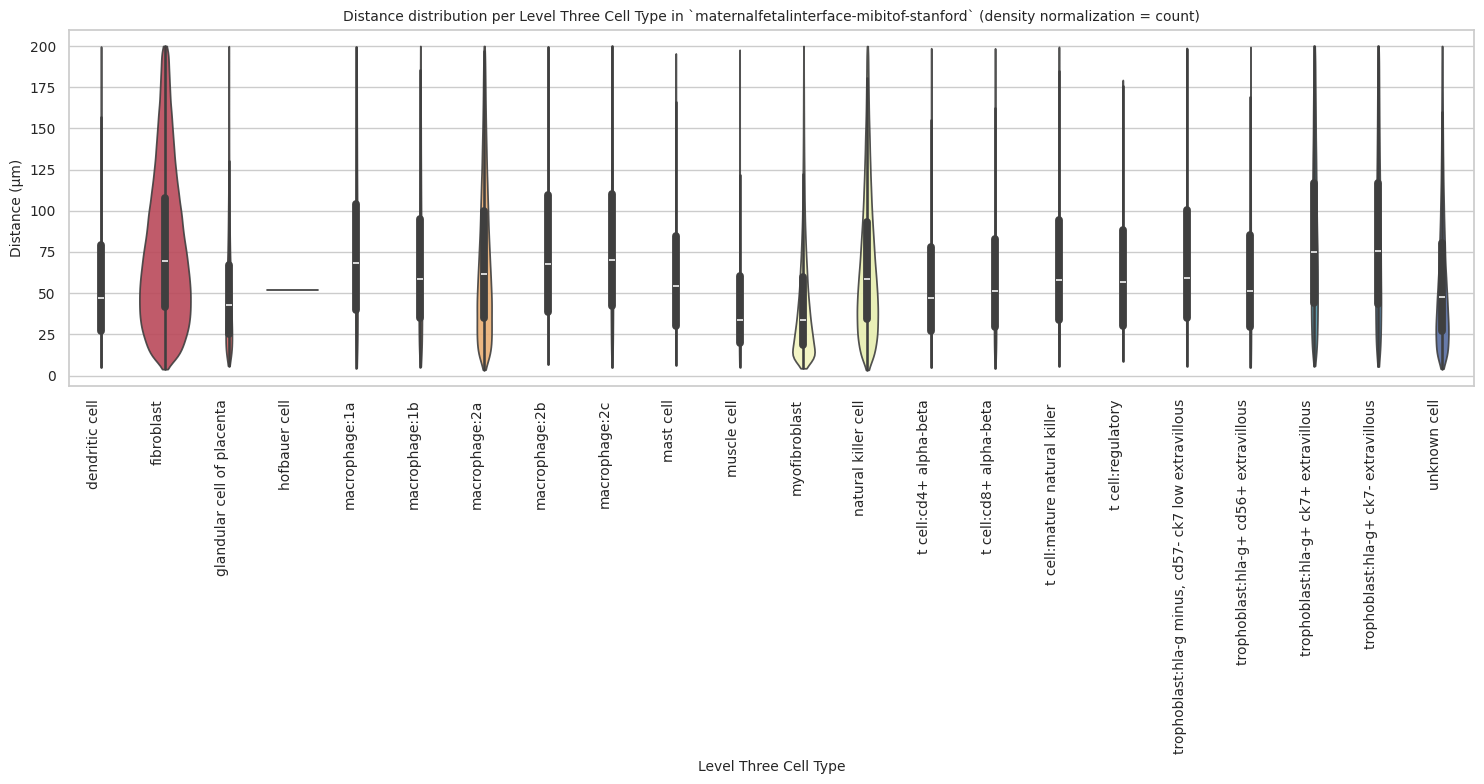import numpy as np
import pandas as pd
import os
import json
import requests
import shutil
import matplotlib.pyplot as plt
import seaborn as sns
from sklearn.preprocessing import normalize
import plotly.express as px
from _cde_compute_edges_from_nodes import *
pd.set_option('display.max_columns', None)
pd.set_option('display.max_rows', None)
# suppress warnings
import warnings
warnings.filterwarnings("ignore")Distance Analysis: maternalfetalinterface-mibitof-stanford
Analyze and visualize cell-to-nearest-endothelial-cell distance distributions for the
maternalfetalinterface-mibitof-stanford dataset.
basepath = "/u/yashjain/hra-cell-distance-analysis/data"
dataset_dir = "maternalfetalinterface-mibitof-stanford"
data_filedir = os.path.join("data-processed-nodes-with-harmonized-cell-types", dataset_dir)
output_edge_dir = os.path.join("data-processed-edges", dataset_dir)
figures_output_dir = "generated-figures"# Function to load your data
def load_data(path, edges=False):
if edges:
column_names = ['cell_id', 'x1', 'y1', 'z1', 'x2', 'y2', 'z2']
data = pd.read_csv(path, header=None, names=column_names)
else:
data = pd.read_csv(path)
return data# Function to read all files ending with "-nodes.csv" in the `data_filedir` directory into a single DataFrame.
# Another additional column `Dataset` is added to identify the dataset name which comes from the filename before the `-nodes.csv` suffix.
# Additionally, function reads all files ending with "-edges.csv" in the `output_edge_dir` directory into a single DataFrame.
# Three additional columns are added "Dataset", "Anchor Cell Type", and "Anchor Cell Type Level" to identify the dataset name, anchor cell type, and anchor cell type level respectively which come from the filename before the `.csv` suffix.
# The three additional columns are created by splitting the filename on the `-` character, and extracting the relevant parts.
# On splitting, the first part is the dataset name, second part is the anchor cell type level, and third part is the anchor cell type, and last part is the `edges` suffix.
# When reading files, check if the file has the correct format (i.e., ends with `-edges.csv`).
# Additionally, the function merges the edges DataFrame with the nodes DataFrame to get the cell type information for the anchor cells.
# This is done by reading the corresponding nodes file from the `data_filedir` directory for each edges file, and merging it with the edges DataFrame on the `cell_id` column.
# The merged DataFrame contains the edges with additional columns for the cell type information.
# The function returns three DataFrames:
# 1. `merged_nodes`: DataFrame containing all nodes with an additional column `Dataset`.
# 2. `merged_edges`: DataFrame containing all edges with additional columns `Dataset`, `Anchor Cell Type`, and `Anchor Cell Type Level`.
# 3. `merged_nodes_for_all_edges`: DataFrame containing all edges with additional columns `Dataset`, `Anchor Cell Type`, `Anchor Cell Type Level`, and the cell type information for cells.
def read_all_edge_datasets(basepath, data_filedir, output_edge_dir):
all_nodes_files = []
all_edges_files = []
all_nodes_edges_files = []
for file in os.listdir(os.path.join(basepath, output_edge_dir)):
if file.endswith("-edges.csv"):
file_path = os.path.join(basepath, output_edge_dir, file)
dataset_name, anchor_cell_type_level, anchor_cell_type = file.replace("-edges.csv", "").split('-')
edges_df = load_data(file_path, edges=False)
edges_df['Dataset'] = dataset_name
edges_df['Anchor Cell Type'] = anchor_cell_type
edges_df['Anchor Cell Type Level'] = anchor_cell_type_level
edges_df.rename(columns={"distance": "Distance"}, inplace=True) # Rename column "distance" to "Distance".
all_edges_files.append(edges_df)
# Read the corresponding nodes file from data_filedir to get the cell type information
nodes_file_path = os.path.join(basepath, data_filedir, f"{dataset_name}-nodes.csv")
nodes_df = load_data(nodes_file_path)
nodes_df['Dataset'] = dataset_name
all_nodes_files.append(nodes_df)
# Add a new 'cell_id' column to nodes_df
nodes_df['cell_id'] = range(len(nodes_df))
# Set 'cell_id' column as index for nodes_df
nodes_df.set_index('cell_id', inplace=True)
# Merge edges_df with nodes_df to get the cell type information for the anchor cells
edges_nodes_df = pd.merge(edges_df, nodes_df[['Level Three Cell Type', 'Level Two Cell Type', 'Level One Cell Type']], how='left', left_on='cell_id', right_index=True)
all_nodes_edges_files.append(edges_nodes_df)
merged_edges = pd.concat(all_edges_files, ignore_index=True)
merged_nodes = pd.concat(all_nodes_files, ignore_index=True)
merged_nodes_for_all_edges = pd.concat(all_nodes_edges_files, ignore_index=True)
return merged_nodes, merged_edges, merged_nodes_for_all_edgesdef create_directory(directory):
if not os.path.exists(directory):
os.makedirs(directory)
print(f"Directory '{directory}' created successfully.")
else:
print(f"Directory '{directory}' already exists.")Get initial statistics and identify endothelial cell categories for dataset.
df_all_nodes, df_all_edges, df_all_edges_with_cell_types = read_all_edge_datasets(basepath, data_filedir, output_edge_dir)df_all_nodes.head(5)| x | y | Original Cell Type | Level Three Cell Type | Level Three CL Label | Level Three CL ID | CL_Match/3 | Level Two Cell Type | Level Two CL Label | Level Two CL ID | CL_Match/2 | Level One Cell Type | Level One CL Label | Level One CL ID | CL_Match/1 | Dataset | |
|---|---|---|---|---|---|---|---|---|---|---|---|---|---|---|---|---|
| 0 | 448.086 | 13.685 | Mac2a | macrophage:2a | macrophage:2a | CL:0000235 | skos:narrowMatch | macrophage | macrophage | CL:0000235 | skos:exactMatch | immune cell | leukocyte | CL:0000738 | skos:exactMatch | 10_31742_1_2 |
| 1 | 486.795 | 245.939 | other | unknown cell | cell:unknown | CL:0000000 | skos:narrowMatch | unknown cell | cell:unknown | CL:0000000 | skos:narrowMatch | unknown cell | cell:unknown | CL:0000000 | skos:narrowMatch | 10_31742_1_2 |
| 2 | 297.160 | 464.899 | Mac2a | macrophage:2a | macrophage:2a | CL:0000235 | skos:narrowMatch | macrophage | macrophage | CL:0000235 | skos:exactMatch | immune cell | leukocyte | CL:0000738 | skos:exactMatch | 10_31742_1_2 |
| 3 | 450.041 | 748.374 | Mac2a | macrophage:2a | macrophage:2a | CL:0000235 | skos:narrowMatch | macrophage | macrophage | CL:0000235 | skos:exactMatch | immune cell | leukocyte | CL:0000738 | skos:exactMatch | 10_31742_1_2 |
| 4 | 3.910 | 125.902 | other | unknown cell | cell:unknown | CL:0000000 | skos:narrowMatch | unknown cell | cell:unknown | CL:0000000 | skos:narrowMatch | unknown cell | cell:unknown | CL:0000000 | skos:narrowMatch | 10_31742_1_2 |
# Print the total number of unique cell types per dataset. Compute separately for each cell type column (Level One Cell Type, Level Two Cell Type, Level Three Cell Type, Original Cell Type).
print("Total number of unique cell types per cell type annnotation level:")
unique_cell_types = {
'Original Cell Type': df_all_nodes['Original Cell Type'].nunique(),
'Level Three Cell Type': df_all_nodes['Level Three Cell Type'].nunique(),
'Level Two Cell Type': df_all_nodes['Level Two Cell Type'].nunique(),
'Level One Cell Type': df_all_nodes['Level One Cell Type'].nunique()
}
for cell_type, count in unique_cell_types.items():
print(f"{cell_type}: {count}")Total number of unique cell types per cell type annnotation level:
Original Cell Type: 26
Level Three Cell Type: 23
Level Two Cell Type: 11
Level One Cell Type: 5# Save the unique cell types containing "endothelial" in name per cell type column (Level One Cell Type, Level Two Cell Type, Level Three Cell Type, Original Cell Type) to a dictionary where the key is the level and the value is a list of unique cell types.
endothelial_cell_types = {
'Original Cell Type': df_all_nodes[df_all_nodes['Original Cell Type'].str.contains("endothelial", case=False, na=False)]['Original Cell Type'].unique().tolist(),
'Level Three Cell Type': df_all_nodes[df_all_nodes['Level Three Cell Type'].str.contains("endothelial", case=False, na=False)]['Level Three Cell Type'].unique().tolist(),
'Level Two Cell Type': df_all_nodes[df_all_nodes['Level Two Cell Type'].str.contains("endothelial", case=False, na=False)]['Level Two Cell Type'].unique().tolist(),
'Level One Cell Type': df_all_nodes[df_all_nodes['Level One Cell Type'].str.contains("endothelial", case=False, na=False)]['Level One Cell Type'].unique().tolist()
}
print("\nEndothelial cell types per cell type annotation level:")
for level, cell_types in endothelial_cell_types.items():
print(f"\n{level}:")
for cell in cell_types:
print(f" - {cell}")
Endothelial cell types per cell type annotation level:
Original Cell Type:
- Endothelial
Level Three Cell Type:
- endothelial cell
Level Two Cell Type:
- endothelial cell
Level One Cell Type:
- endothelial celltype_field_list = ["Level Three Cell Type", "Level Two Cell Type", "Level One Cell Type"] # Skipping Original Cell Type as it is not a hierarchical level.
# Define the anchor cell type (type of endothelial cell) for each level in type_field_list based on available categories in the previous cell. The distance analysis at all three levels will be limited to the specified anchor cell type.
anchor_cell_type_dict = {
'Level Three Cell Type': 'endothelial cell',
'Level Two Cell Type': 'endothelial cell',
'Level One Cell Type': 'endothelial cell'
}Process datasets to add region information to Nodes files.
df_all_nodes.head()| x | y | Original Cell Type | Level Three Cell Type | Level Three CL Label | Level Three CL ID | CL_Match/3 | Level Two Cell Type | Level Two CL Label | Level Two CL ID | CL_Match/2 | Level One Cell Type | Level One CL Label | Level One CL ID | CL_Match/1 | Dataset | |
|---|---|---|---|---|---|---|---|---|---|---|---|---|---|---|---|---|
| 0 | 448.086 | 13.685 | Mac2a | macrophage:2a | macrophage:2a | CL:0000235 | skos:narrowMatch | macrophage | macrophage | CL:0000235 | skos:exactMatch | immune cell | leukocyte | CL:0000738 | skos:exactMatch | 10_31742_1_2 |
| 1 | 486.795 | 245.939 | other | unknown cell | cell:unknown | CL:0000000 | skos:narrowMatch | unknown cell | cell:unknown | CL:0000000 | skos:narrowMatch | unknown cell | cell:unknown | CL:0000000 | skos:narrowMatch | 10_31742_1_2 |
| 2 | 297.160 | 464.899 | Mac2a | macrophage:2a | macrophage:2a | CL:0000235 | skos:narrowMatch | macrophage | macrophage | CL:0000235 | skos:exactMatch | immune cell | leukocyte | CL:0000738 | skos:exactMatch | 10_31742_1_2 |
| 3 | 450.041 | 748.374 | Mac2a | macrophage:2a | macrophage:2a | CL:0000235 | skos:narrowMatch | macrophage | macrophage | CL:0000235 | skos:exactMatch | immune cell | leukocyte | CL:0000738 | skos:exactMatch | 10_31742_1_2 |
| 4 | 3.910 | 125.902 | other | unknown cell | cell:unknown | CL:0000000 | skos:narrowMatch | unknown cell | cell:unknown | CL:0000000 | skos:narrowMatch | unknown cell | cell:unknown | CL:0000000 | skos:narrowMatch | 10_31742_1_2 |
# The "Unique Region" column is created by mapping the region names based on the full dataset name. For this dataset (maternalfetalinterface-mibitof-stanford), the region is the dataset name itself.
df_all_nodes['Unique Region'] = dataset_dir
# df_all_nodes['Unique Region'] = df_all_nodes['Dataset'].map(region_map)
# df_all_nodes['Unique Region'] = df_all_nodes['Dataset'].str.split('-').str[1].map(region_map)
# Check if the new columns are created correctly.
df_all_nodes[['Dataset', 'Unique Region']].head(5)| Dataset | Unique Region | |
|---|---|---|
| 0 | 10_31742_1_2 | maternalfetalinterface-mibitof-stanford |
| 1 | 10_31742_1_2 | maternalfetalinterface-mibitof-stanford |
| 2 | 10_31742_1_2 | maternalfetalinterface-mibitof-stanford |
| 3 | 10_31742_1_2 | maternalfetalinterface-mibitof-stanford |
| 4 | 10_31742_1_2 | maternalfetalinterface-mibitof-stanford |
# Print all unique regions in the data.
print("\nUnique Regions in the data:")
print(df_all_nodes['Unique Region'].unique())
# Print the total number of unique regions.
print(f"Total number of unique regions: {df_all_nodes['Unique Region'].nunique()}")
# Print number of unique datasets per unique region.
print("\nNumber of unique datasets per unique region:")
for region in df_all_nodes['Unique Region'].unique():
num_datasets = df_all_nodes[df_all_nodes['Unique Region'] == region]['Dataset'].nunique()
print(f"{region}: {num_datasets}")
Unique Regions in the data:
['maternalfetalinterface-mibitof-stanford']
Total number of unique regions: 1
Number of unique datasets per unique region:
maternalfetalinterface-mibitof-stanford: 209Process datasets to add region information to Edges files.
df_all_edges.head(5)| cell_id | x1 | y1 | z1 | x2 | y2 | z2 | Distance | Dataset | Anchor Cell Type | Anchor Cell Type Level | |
|---|---|---|---|---|---|---|---|---|---|---|---|
| 0 | 0 | 448.086 | 13.685 | 0 | 475.456 | 50.439 | 0 | 45.825467 | 10_31742_1_2 | endothelial cell | Level Three Cell Type |
| 1 | 7 | 465.290 | 133.722 | 0 | 469.982 | 70.380 | 0 | 63.515540 | 10_31742_1_2 | endothelial cell | Level Three Cell Type |
| 2 | 59 | 450.041 | 1.173 | 0 | 475.456 | 50.439 | 0 | 55.435196 | 10_31742_1_2 | endothelial cell | Level Three Cell Type |
| 3 | 82 | 477.411 | 163.438 | 0 | 469.982 | 70.380 | 0 | 93.354065 | 10_31742_1_2 | endothelial cell | Level Three Cell Type |
| 4 | 99 | 420.325 | 31.671 | 0 | 389.045 | 42.619 | 0 | 33.140566 | 10_31742_1_2 | endothelial cell | Level Three Cell Type |
# The "Unique Region" column is created by mapping the region names based on the full dataset name. For this dataset (maternalfetalinterface-mibitof-stanford), the region is the dataset name itself.
df_all_edges['Unique Region'] = dataset_dir
# Check if the new columns are created correctly.
df_all_edges[['Dataset', 'Unique Region']].head(5)| Dataset | Unique Region | |
|---|---|---|
| 0 | 10_31742_1_2 | maternalfetalinterface-mibitof-stanford |
| 1 | 10_31742_1_2 | maternalfetalinterface-mibitof-stanford |
| 2 | 10_31742_1_2 | maternalfetalinterface-mibitof-stanford |
| 3 | 10_31742_1_2 | maternalfetalinterface-mibitof-stanford |
| 4 | 10_31742_1_2 | maternalfetalinterface-mibitof-stanford |
# Print all unique regions in the data.
print("\nUnique Regions in the data:")
print(df_all_edges['Unique Region'].unique())
# Print the total number of unique regions.
print(f"Total number of unique regions: {df_all_edges['Unique Region'].nunique()}")
# Print number of unique datasets per unique region.
print("\nNumber of unique datasets per unique region:")
for region in df_all_edges['Unique Region'].unique():
num_datasets = df_all_edges[df_all_edges['Unique Region'] == region]['Dataset'].nunique()
print(f"{region}: {num_datasets}")
Unique Regions in the data:
['maternalfetalinterface-mibitof-stanford']
Total number of unique regions: 1
Number of unique datasets per unique region:
maternalfetalinterface-mibitof-stanford: 201df_all_edges_with_cell_types['Unique Region'] = dataset_dir
# df_all_edges_with_cell_types['Unique Region'] = df_all_edges_with_cell_types['Dataset'].map(region_map)
# Check if the new columns are created correctly.
df_all_edges_with_cell_types[['Dataset', 'Unique Region']].head(5)| Dataset | Unique Region | |
|---|---|---|
| 0 | 10_31742_1_2 | maternalfetalinterface-mibitof-stanford |
| 1 | 10_31742_1_2 | maternalfetalinterface-mibitof-stanford |
| 2 | 10_31742_1_2 | maternalfetalinterface-mibitof-stanford |
| 3 | 10_31742_1_2 | maternalfetalinterface-mibitof-stanford |
| 4 | 10_31742_1_2 | maternalfetalinterface-mibitof-stanford |
df_all_nodes.head(1)| x | y | Original Cell Type | Level Three Cell Type | Level Three CL Label | Level Three CL ID | CL_Match/3 | Level Two Cell Type | Level Two CL Label | Level Two CL ID | CL_Match/2 | Level One Cell Type | Level One CL Label | Level One CL ID | CL_Match/1 | Dataset | Unique Region | |
|---|---|---|---|---|---|---|---|---|---|---|---|---|---|---|---|---|---|
| 0 | 448.086 | 13.685 | Mac2a | macrophage:2a | macrophage:2a | CL:0000235 | skos:narrowMatch | macrophage | macrophage | CL:0000235 | skos:exactMatch | immune cell | leukocyte | CL:0000738 | skos:exactMatch | 10_31742_1_2 | maternalfetalinterface-mibitof-stanford |
df_all_edges.head(1)| cell_id | x1 | y1 | z1 | x2 | y2 | z2 | Distance | Dataset | Anchor Cell Type | Anchor Cell Type Level | Unique Region | |
|---|---|---|---|---|---|---|---|---|---|---|---|---|
| 0 | 0 | 448.086 | 13.685 | 0 | 475.456 | 50.439 | 0 | 45.825467 | 10_31742_1_2 | endothelial cell | Level Three Cell Type | maternalfetalinterface-mibitof-stanford |
df_all_edges_with_cell_types.head(1)| cell_id | x1 | y1 | z1 | x2 | y2 | z2 | Distance | Dataset | Anchor Cell Type | Anchor Cell Type Level | Level Three Cell Type | Level Two Cell Type | Level One Cell Type | Unique Region | |
|---|---|---|---|---|---|---|---|---|---|---|---|---|---|---|---|
| 0 | 0 | 448.086 | 13.685 | 0 | 475.456 | 50.439 | 0 | 45.825467 | 10_31742_1_2 | endothelial cell | Level Three Cell Type | macrophage:2a | macrophage | immune cell | maternalfetalinterface-mibitof-stanford |
Node Analysis
# Plot number of cells per cell type in the same plot. Color by cell type and unique region. Output figure saved in existing `figures_output_dir`.
def plot_cells_per_celltype(df, type_field, output_dir):
plt.figure(figsize=(20, 8))
plt.rcParams["svg.fonttype"] = 'none' # to store text as text, not as path
sns.countplot(data=df, x=type_field, palette='Spectral', hue='Unique Region')
plt.title(f'Number of Cells per {type_field} in `{dataset_dir}`')
plt.xticks(rotation=90)
plt.tight_layout()
plt.savefig(os.path.join(output_dir, f'{dataset_dir}_cells_per_celltype_{type_field}.png'), dpi=300,
bbox_inches='tight',
pad_inches=0.5)
plt.savefig(os.path.join(output_dir, f'{dataset_dir}_cells_per_celltype_{type_field}.svg'), dpi=300,
bbox_inches='tight',
pad_inches=0.5)
plt.legend(title='Unique Region', bbox_to_anchor=(0.85, 1), loc='upper left')
plt.xlabel(type_field)
# For numbers on y-axis, do not use scientific notation.
plt.ticklabel_format(style='plain', axis='y')
# Set y-axis label
plt.ylabel('Number of Cells')
plt.grid(axis='y', linestyle='--', alpha=0.7)
plt.tight_layout()
# Show the plot
plt.show()
plt.close()
for type_field in type_field_list:
plot_cells_per_celltype(df_all_nodes, type_field, os.path.join(basepath, figures_output_dir))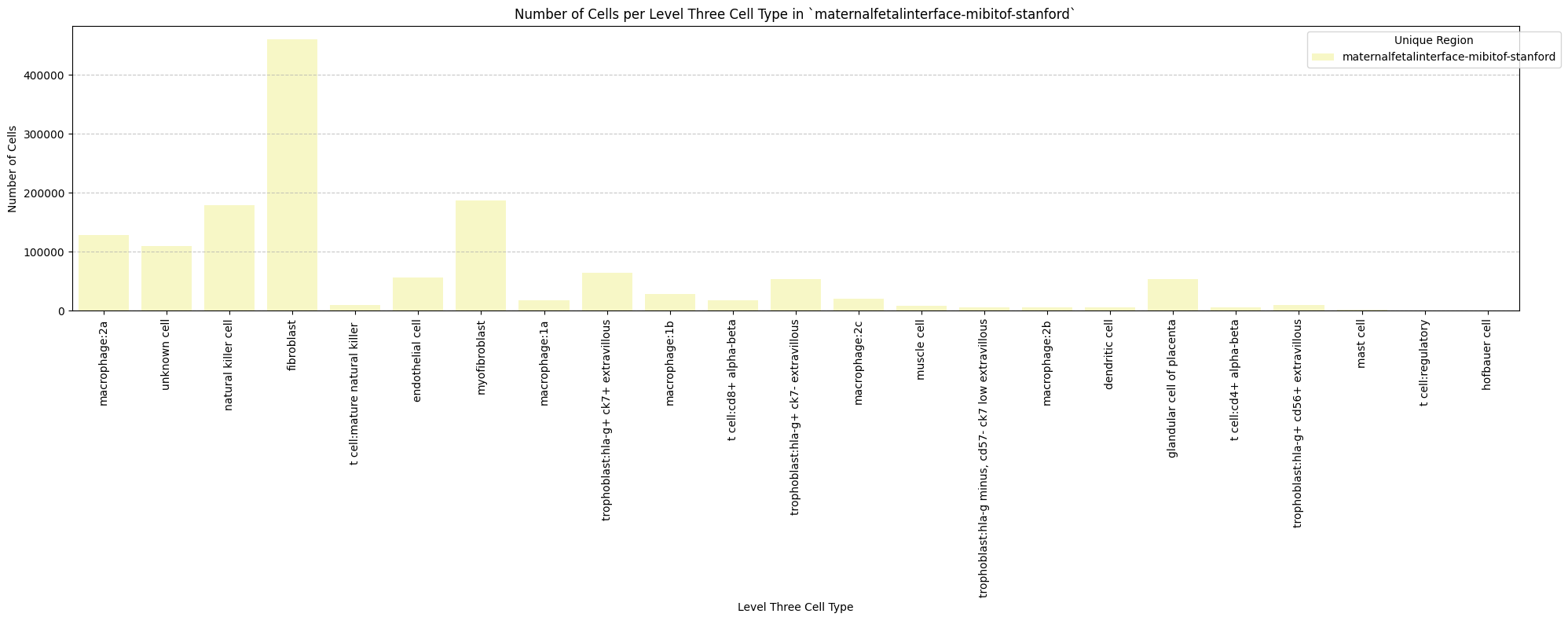
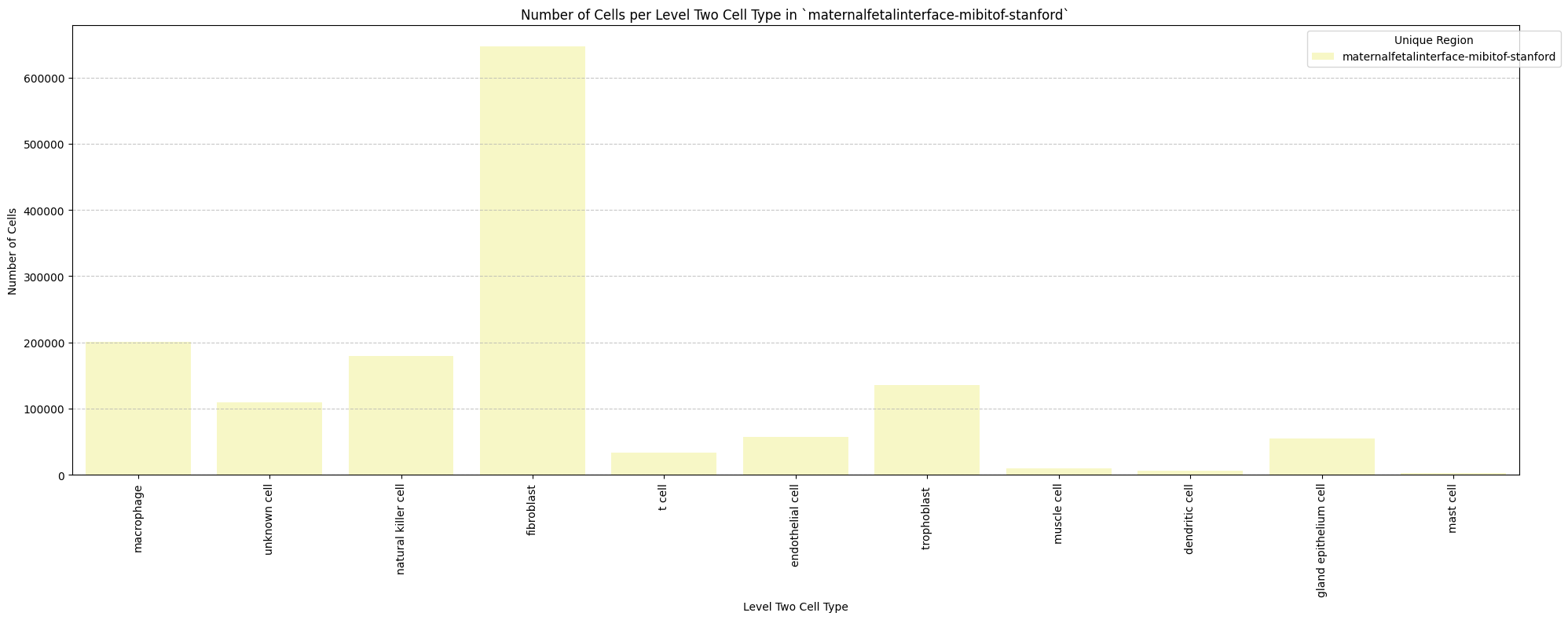
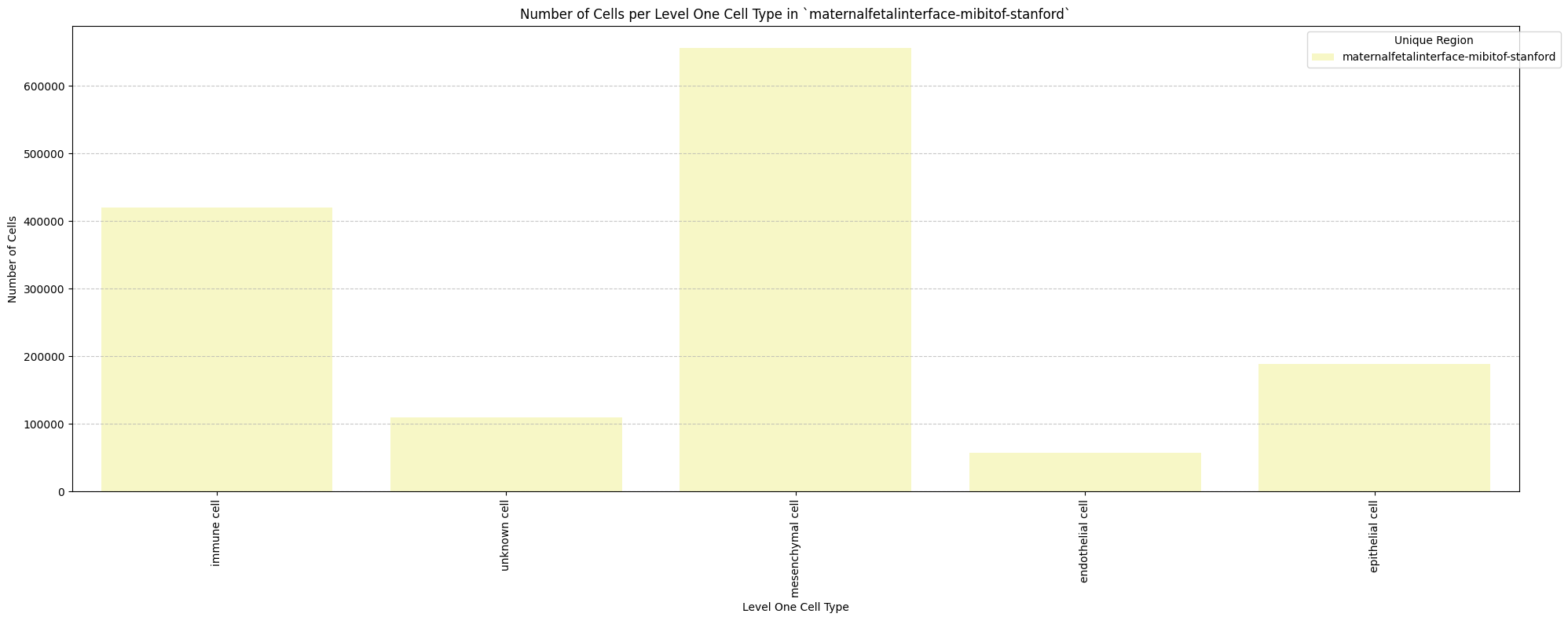
Distance Analysis
# Get mean, median, minimum, maximum distance per unique region per anchor cell type.
df_distance_stats = df_all_edges_with_cell_types.groupby(['Unique Region', 'Anchor Cell Type', 'Anchor Cell Type Level']).agg(
mean_distance=('Distance', 'mean'),
median_distance=('Distance', 'median'),
min_distance=('Distance', 'min'),
max_distance=('Distance', 'max')
).reset_index()
# Print the first few rows of the distance statistics DataFrame.
df_distance_stats| Unique Region | Anchor Cell Type | Anchor Cell Type Level | mean_distance | median_distance | min_distance | max_distance | |
|---|---|---|---|---|---|---|---|
| 0 | maternalfetalinterface-mibitof-stanford | endothelial cell | Level One Cell Type | 67.89132 | 57.54213 | 3.49721 | 199.994111 |
| 1 | maternalfetalinterface-mibitof-stanford | endothelial cell | Level Three Cell Type | 67.89132 | 57.54213 | 3.49721 | 199.994111 |
| 2 | maternalfetalinterface-mibitof-stanford | endothelial cell | Level Two Cell Type | 67.89132 | 57.54213 | 3.49721 | 199.994111 |
Level One Cell Type Analysis
# Get mean, median, minimum, maximum distance per cell type in all unique regions.
cell_type_level = 'Level One Cell Type'
df_all_edges_with_cell_type_level = df_all_edges_with_cell_types[(df_all_edges_with_cell_types['Anchor Cell Type Level'] == cell_type_level) & (df_all_edges_with_cell_types['Anchor Cell Type'] == anchor_cell_type_dict[cell_type_level])]
df_distance_stats_cell_type_level = df_all_edges_with_cell_type_level.groupby([cell_type_level, 'Unique Region']).agg(
mean_distance=('Distance', 'mean'),
median_distance=('Distance', 'median'),
min_distance=('Distance', 'min'),
max_distance=('Distance', 'max')
).reset_index()
df_distance_stats_cell_type_level| Level One Cell Type | Unique Region | mean_distance | median_distance | min_distance | max_distance | |
|---|---|---|---|---|---|---|
| 0 | epithelial cell | maternalfetalinterface-mibitof-stanford | 71.729685 | 60.817785 | 5.083000 | 199.994111 |
| 1 | immune cell | maternalfetalinterface-mibitof-stanford | 69.292915 | 59.560480 | 3.497210 | 199.992200 |
| 2 | mesenchymal cell | maternalfetalinterface-mibitof-stanford | 67.481963 | 57.231769 | 3.910000 | 199.987996 |
| 3 | unknown cell | maternalfetalinterface-mibitof-stanford | 58.887208 | 47.444914 | 4.211199 | 199.992200 |
# Get top five and bottom five cell types with respect to mean distance in each unique region separately.
def get_top_bottom_cell_types_by_mean(df, cell_type_level, unique_region, top_n=5):
# Filter the DataFrame for the specified unique region and cell type level
df_filtered = df[df['Unique Region'] == unique_region]
# Group by the specified cell type level and calculate mean distance
df_grouped = df_filtered.groupby(cell_type_level).agg(mean_distance=('Distance', 'mean')).reset_index()
# Sort by mean distance to get top and bottom cell types
df_sorted = df_grouped.sort_values(by='mean_distance', ascending=False)
# Get top N and bottom N cell types
top_cell_types = df_sorted.head(top_n)
bottom_cell_types = df_sorted.tail(top_n)
return top_cell_types, bottom_cell_types
# Get top and bottom cell types for each unique region in the dataset.
unique_regions = df_all_edges_with_cell_type_level['Unique Region'].unique()
for region in unique_regions:
top_bottom = get_top_bottom_cell_types_by_mean(df_all_edges_with_cell_type_level, cell_type_level, region)
print(f"\nTop 5 cell types in {region}:")
print(top_bottom[0])
print(f"\nBottom 5 cell types in {region}:")
print(top_bottom[1])
Top 5 cell types in maternalfetalinterface-mibitof-stanford:
Level One Cell Type mean_distance
0 epithelial cell 71.729685
1 immune cell 69.292915
2 mesenchymal cell 67.481963
3 unknown cell 58.887208
Bottom 5 cell types in maternalfetalinterface-mibitof-stanford:
Level One Cell Type mean_distance
0 epithelial cell 71.729685
1 immune cell 69.292915
2 mesenchymal cell 67.481963
3 unknown cell 58.887208# Get top five and bottom five cell types with respect to median distance in each unique region separately.
def get_top_bottom_cell_types_by_median(df, cell_type_level, unique_region, top_n=5):
# Filter the DataFrame for the specified unique region and cell type level
df_filtered = df[df['Unique Region'] == unique_region]
# Group by the specified cell type level and calculate median distance
df_grouped = df_filtered.groupby(cell_type_level).agg(median_distance=('Distance', 'median')).reset_index()
# Sort by median distance to get top and bottom cell types
df_sorted = df_grouped.sort_values(by='median_distance', ascending=False)
# Get top N and bottom N cell types
top_cell_types = df_sorted.head(top_n)
bottom_cell_types = df_sorted.tail(top_n)
return top_cell_types, bottom_cell_types
# Get top and bottom cell types for each unique region in the dataset.
unique_regions = df_all_edges_with_cell_type_level['Unique Region'].unique()
for region in unique_regions:
top_bottom = get_top_bottom_cell_types_by_median(df_all_edges_with_cell_type_level, cell_type_level, region)
print(f"\nTop 5 cell types in {region}:")
print(top_bottom[0])
print(f"\nBottom 5 cell types in {region}:")
print(top_bottom[1])
Top 5 cell types in maternalfetalinterface-mibitof-stanford:
Level One Cell Type median_distance
0 epithelial cell 60.817785
1 immune cell 59.560480
2 mesenchymal cell 57.231769
3 unknown cell 47.444914
Bottom 5 cell types in maternalfetalinterface-mibitof-stanford:
Level One Cell Type median_distance
0 epithelial cell 60.817785
1 immune cell 59.560480
2 mesenchymal cell 57.231769
3 unknown cell 47.444914# Calculate regional variability
def calculate_regional_variability(df_all_edges_with_cell_type_level, cell_type_level):
""" Calculate regional variability for distances in the given DataFrame.
"""
regional_variability = df_all_edges_with_cell_type_level.groupby('Unique Region')['Distance'].agg([
('mean', 'mean'),
('std', 'std')
]).round(2)
# Add CV as percentage
regional_variability['CV (%)'] = (regional_variability['std'] / regional_variability['mean'] * 100).round(1)
print("\nRegional Variability Analysis:")
print("Mean: Average distance in each region")
print("Std: Standard deviation of distances")
print("CV: Coefficient of Variation (std/mean * 100%)")
print(regional_variability)
# Calculate variability for each cell type
cell_type_variability = df_all_edges_with_cell_type_level.groupby(cell_type_level)['Distance'].agg([
('mean', 'mean'),
('std', 'std')
]).round(2)
# Add CV as percentage
cell_type_variability['CV (%)'] = (cell_type_variability['std'] / cell_type_variability['mean'] * 100).round(1)
print("\nCell Type Variability Analysis (sorted by CV):")
print(cell_type_variability.sort_values('CV (%)', ascending=False))
calculate_regional_variability(df_all_edges_with_cell_type_level, cell_type_level)
Regional Variability Analysis:
Mean: Average distance in each region
Std: Standard deviation of distances
CV: Coefficient of Variation (std/mean * 100%)
mean std CV (%)
Unique Region
maternalfetalinterface-mibitof-stanford 67.89 44.96 66.2
Cell Type Variability Analysis (sorted by CV):
mean std CV (%)
Level One Cell Type
unknown cell 58.89 41.57 70.6
mesenchymal cell 67.48 45.43 67.3
epithelial cell 71.73 46.54 64.9
immune cell 69.29 44.09 63.6# Define the standard region sequence for plots (Get all unique values in Unique Region column as a list.)
regions = df_all_edges_with_cell_types['Unique Region'].unique().tolist()
print("\nRegions in the data:")
print(regions)
Regions in the data:
['maternalfetalinterface-mibitof-stanford']# Generate Violin Plot
def plot_violin_cells_per_celltype(df_all_edges_with_cell_type_level, cell_type_level, output_dir, density_norm='area'):
sns.set_style("whitegrid")
sns.set_context("notebook", rc={"grid.linewidth": 2})
plt.figure(figsize=(10, 6))
plt.rcParams["svg.fonttype"] = 'none' # to store text as text, not as path
sns.violinplot(data=df_all_edges_with_cell_type_level, x=cell_type_level, y="Distance", density_norm=density_norm, common_norm=True, cut=0, inner="box", split=False, palette='Spectral', alpha=.9)
sns.set_theme(style="whitegrid")
sns.set_context("paper")
font_size = 10
plt.legend(fontsize=font_size)
plt.title(f'Violin Plot of distances by {cell_type_level} (Density Normalization: {density_norm})', fontsize=font_size)
plt.xlabel(f'{cell_type_level}', fontsize=font_size)
plt.ylabel('Distance (\u03bcm)', fontsize=font_size)
# Increase font size for all text in the figure
plt.xticks(fontsize=font_size)
plt.xticks(rotation=90)
plt.yticks(fontsize=font_size)
plt.tight_layout()
plt.savefig(os.path.join(output_dir, f'{dataset_dir}_violin_cells_per_celltype_{cell_type_level}.png'), dpi=300,
bbox_inches='tight',
pad_inches=0.5)
plt.savefig(os.path.join(output_dir, f'{dataset_dir}_violin_cells_per_celltype_{cell_type_level}.svg'), dpi=300,
bbox_inches='tight',
pad_inches=0.5)
plt.show()
plot_violin_cells_per_celltype(df_all_edges_with_cell_type_level, cell_type_level, os.path.join(basepath, figures_output_dir), density_norm='area')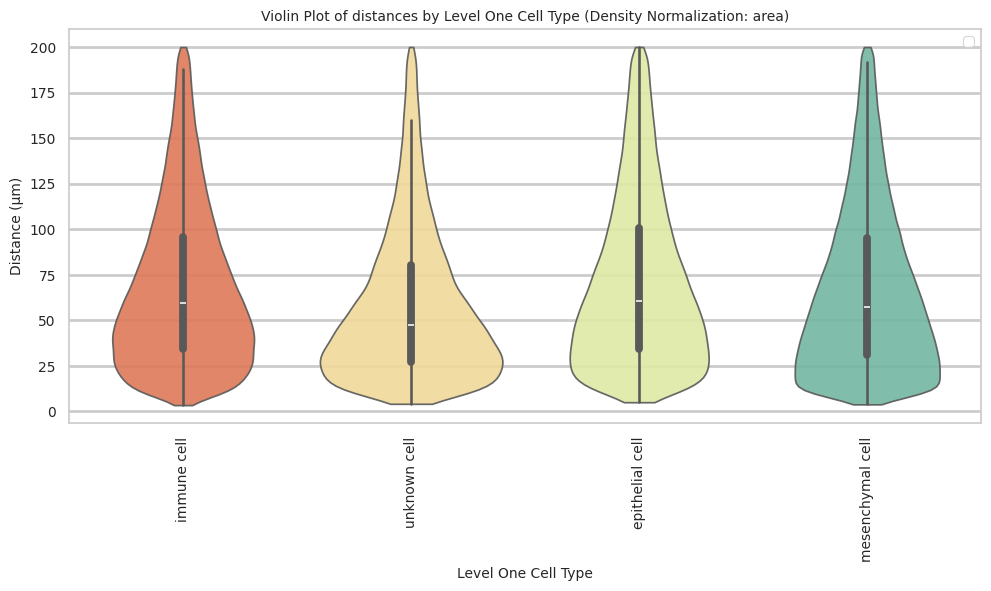
# Boxplots of distribution of distances by cell type and region.
def plot_distance_distribution_boxplots_by_region(df_all_edges_with_cell_type_level, cell_type_level, output_dir):
plt.figure(figsize=(16, 8))
plt.rcParams["svg.fonttype"] = 'none' # to store text as text, not as path
# Create categorical type with only the regions that exist in the data
available_regions = [r for r in regions if r in df_all_edges_with_cell_type_level['Unique Region'].unique()]
df_all_edges_with_cell_type_level['Unique Region'] = pd.Categorical(
df_all_edges_with_cell_type_level['Unique Region'],
categories=available_regions,
ordered=True
)
# Make box plot.
sns.boxplot(data=df_all_edges_with_cell_type_level, x=cell_type_level, y='Distance', hue='Unique Region', showfliers=False, palette='Spectral') # viridis or Spectral palette for better color distinction
font_size = 10
plt.xticks(rotation=90, ha='right', fontsize=font_size)
plt.yticks(fontsize=font_size)
plt.title(f'Distribution of distances by {cell_type_level} and region', fontsize=font_size)
plt.xlabel(f'{cell_type_level}', fontsize=font_size)
plt.ylabel('Distance (\u03bcm)', fontsize=font_size)
plt.legend(bbox_to_anchor=(1, 1), loc='upper left')
plt.tight_layout()
plt.savefig(os.path.join(output_dir, f'{dataset_dir}_distance_distribution_boxplots_by_region_{cell_type_level}.png'), dpi=300,
bbox_inches='tight',
pad_inches=0.5)
plt.savefig(os.path.join(output_dir, f'{dataset_dir}_distance_distribution_boxplots_by_region_{cell_type_level}.svg'), dpi=300,
bbox_inches='tight',
pad_inches=0.5)
plt.show()
plot_distance_distribution_boxplots_by_region(df_all_edges_with_cell_type_level, cell_type_level, os.path.join(basepath, figures_output_dir))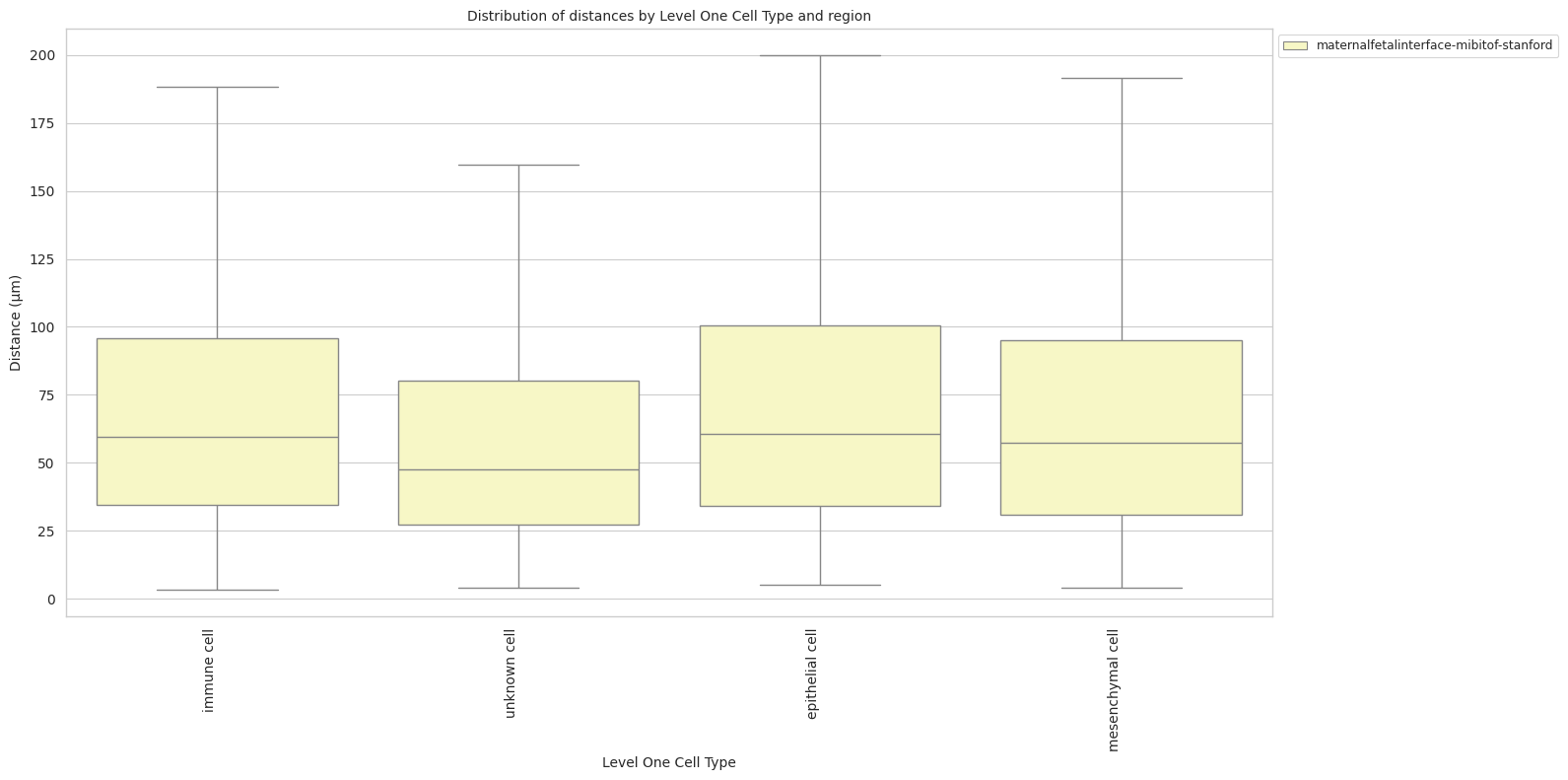
# Boxplots of distribution of distances by cell type and region.
def plot_distance_distribution_heatmap(df_all_edges_with_cell_type_level, cell_type_level, output_dir):
pivot_data = df_all_edges_with_cell_type_level.pivot_table(
values='Distance',
index=cell_type_level,
columns='Unique Region',
aggfunc='median'
)
plt.figure(figsize=(15, 10))
plt.rcParams["svg.fonttype"] = 'none' # to store text as text, not as path
sns.heatmap(pivot_data, annot=True, fmt='.1f', cmap='Spectral')
plt.title(f'Heatmap of median distances by {cell_type_level}', fontsize=12)
font_size = 10
plt.xticks(rotation=90, ha='right', fontsize=font_size)
plt.yticks(fontsize=font_size)
plt.xlabel('Unique Region', fontsize=font_size)
plt.ylabel(f'{cell_type_level}', fontsize=font_size)
plt.tight_layout()
plt.savefig(os.path.join(output_dir, f'{dataset_dir}_distance_distribution_heatmap_{cell_type_level}.png'), dpi=300,
bbox_inches='tight',
pad_inches=0.5)
plt.savefig(os.path.join(output_dir, f'{dataset_dir}_distance_distribution_heatmap_{cell_type_level}.svg'), dpi=300,
bbox_inches='tight',
pad_inches=0.5)
plt.show()
plot_distance_distribution_heatmap(df_all_edges_with_cell_type_level, cell_type_level, os.path.join(basepath, figures_output_dir))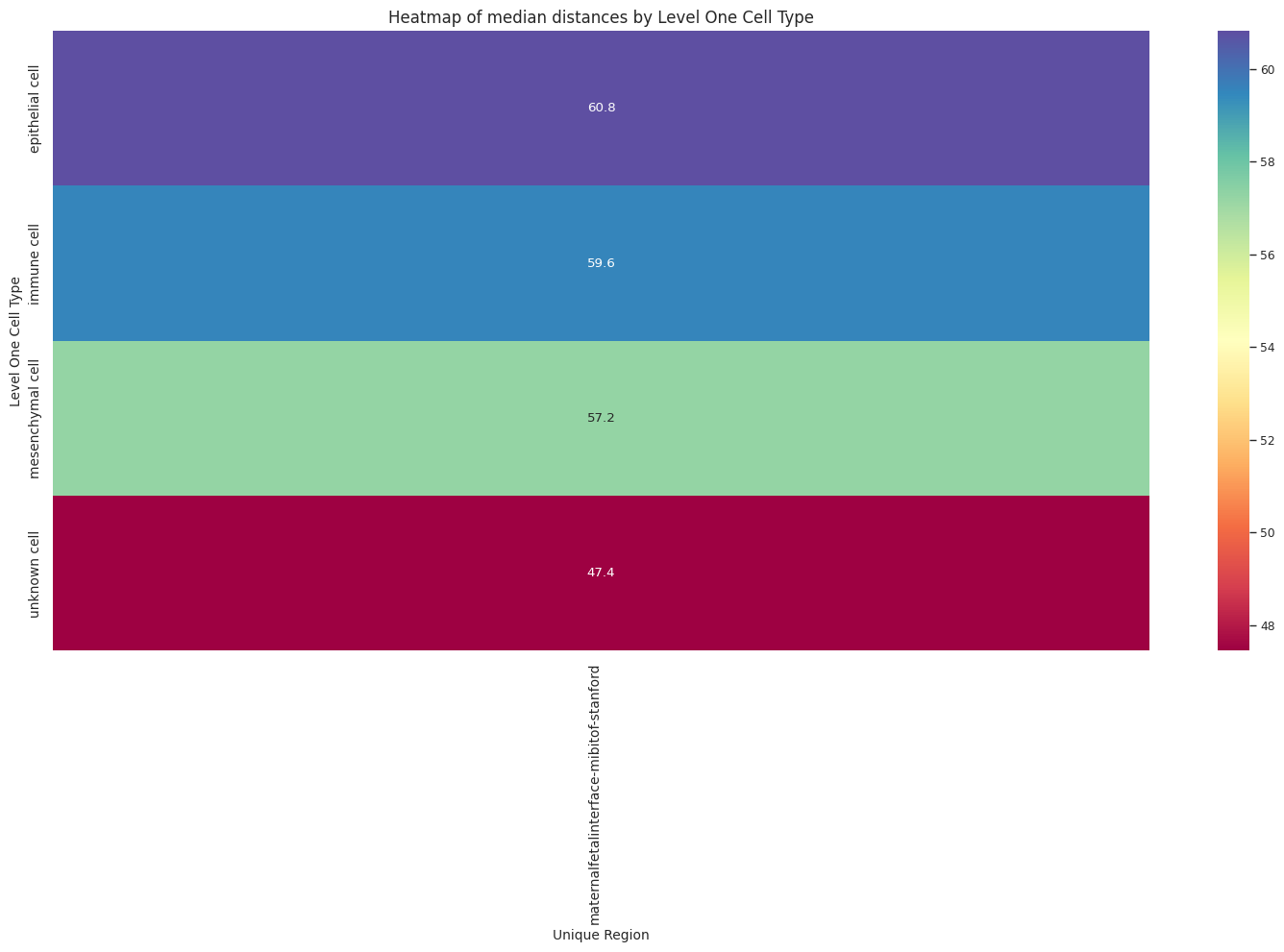
# Generate Violin Plot per unique region.
def plot_violin_plots_all_regions(df_all_edges_with_cell_type_level, cell_type_level, output_dir, density_norm="area"):
sns.set_style("whitegrid")
sns.set_context("notebook", rc={"grid.linewidth": 1})
font_size = 10
plt.figure(figsize=(15, 8))
plt.rcParams["svg.fonttype"] = 'none' # to store text as text, not as path
# Keep the sequence of Cell Types consistent across plots.
cell_types = sorted(df_all_edges_with_cell_type_level[cell_type_level].unique())
# Create a color palette based on the number of unique classes
color_palette = sns.color_palette("Spectral", n_colors=len(cell_types))
# Create a dictionary mapping class to color
class_color_dict = dict(zip(cell_types, color_palette))
# Create the violin plot for the entire dataset
sns.violinplot(
data=df_all_edges_with_cell_type_level,
x=cell_type_level,
y="Distance",
density_norm=density_norm,
common_norm=True,
cut=0,
inner="box",
split=False,
palette=class_color_dict,
alpha=.9,
hue=cell_type_level,
legend=False,
order=cell_types,
fill=True
)
# Set title and labels
plt.title(f'Distance distribution per {cell_type_level} in `{dataset_dir}` (density normalization = {density_norm})', fontsize=font_size)
plt.xlabel(f'{cell_type_level}', fontsize=font_size)
plt.ylabel('Distance (μm)', fontsize=font_size)
# Rotate x-axis labels and adjust font size
plt.xticks(rotation=90, ha='right', fontsize=font_size)
plt.yticks(fontsize=font_size)
plt.tight_layout()
plt.savefig(os.path.join(output_dir, f'{dataset_dir}_violin_plots_all_regions_{cell_type_level}.png'), dpi=300,
bbox_inches='tight',
pad_inches=0.5)
plt.savefig(os.path.join(output_dir, f'{dataset_dir}_violin_plots_all_regions_{cell_type_level}.svg'), dpi=300,
bbox_inches='tight',
pad_inches=0.5)
plt.show()
plot_violin_plots_all_regions(df_all_edges_with_cell_type_level, cell_type_level, os.path.join(basepath, figures_output_dir), density_norm="count") # density_norm="count" or "area" can be used based on preference.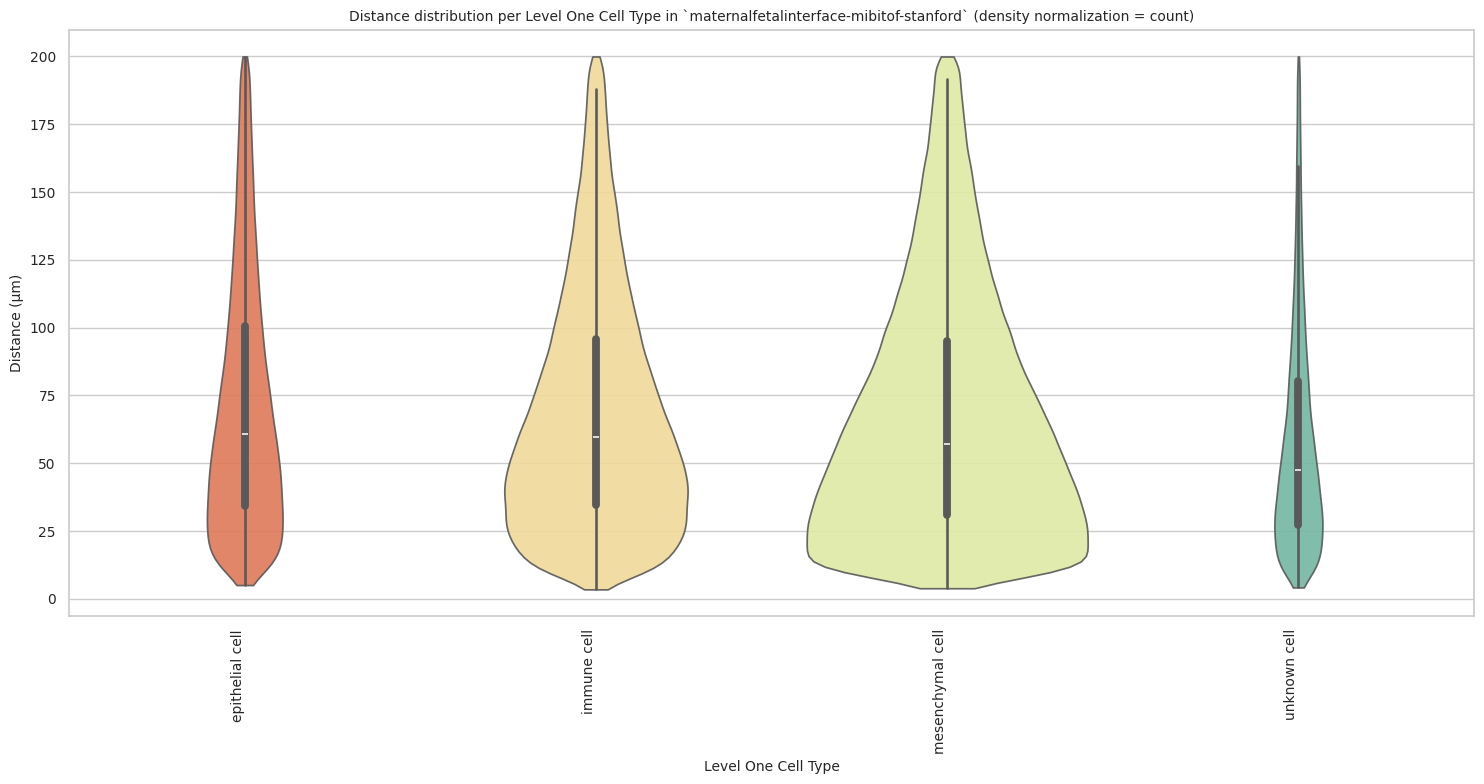
Level Two Cell Type Analysis
# Get mean, median, minimum, maximum distance per cell type in all unique regions.
cell_type_level = 'Level Two Cell Type'
df_all_edges_with_cell_type_level = df_all_edges_with_cell_types[(df_all_edges_with_cell_types['Anchor Cell Type Level'] == cell_type_level) & (df_all_edges_with_cell_types['Anchor Cell Type'] == anchor_cell_type_dict[cell_type_level])]
df_distance_stats_cell_type_level = df_all_edges_with_cell_type_level.groupby([cell_type_level, 'Unique Region']).agg(
mean_distance=('Distance', 'mean'),
median_distance=('Distance', 'median'),
min_distance=('Distance', 'min'),
max_distance=('Distance', 'max')
).reset_index()
df_distance_stats_cell_type_level| Level Two Cell Type | Unique Region | mean_distance | median_distance | min_distance | max_distance | |
|---|---|---|---|---|---|---|
| 0 | dendritic cell | maternalfetalinterface-mibitof-stanford | 58.324142 | 47.317462 | 5.098016 | 199.666668 |
| 1 | fibroblast | maternalfetalinterface-mibitof-stanford | 67.813447 | 57.627086 | 3.910000 | 199.987996 |
| 2 | gland epithelium cell | maternalfetalinterface-mibitof-stanford | 51.287235 | 42.921044 | 5.981150 | 199.885151 |
| 3 | macrophage | maternalfetalinterface-mibitof-stanford | 72.110494 | 62.600309 | 3.604842 | 199.992200 |
| 4 | mast cell | maternalfetalinterface-mibitof-stanford | 63.148860 | 54.321564 | 6.448537 | 195.472628 |
| 5 | muscle cell | maternalfetalinterface-mibitof-stanford | 45.641366 | 33.661210 | 5.487947 | 197.687141 |
| 6 | natural killer cell | maternalfetalinterface-mibitof-stanford | 67.902679 | 58.362562 | 3.497210 | 199.930654 |
| 7 | t cell | maternalfetalinterface-mibitof-stanford | 62.509286 | 52.500396 | 4.576538 | 199.463659 |
| 8 | trophoblast | maternalfetalinterface-mibitof-stanford | 81.257066 | 72.895027 | 5.083000 | 199.994111 |
| 9 | unknown cell | maternalfetalinterface-mibitof-stanford | 58.887208 | 47.444914 | 4.211199 | 199.992200 |
# Get top and bottom cell types for each unique region in the dataset.
unique_regions = df_all_edges_with_cell_type_level['Unique Region'].unique()
for region in unique_regions:
top_bottom = get_top_bottom_cell_types_by_mean(df_all_edges_with_cell_type_level, cell_type_level, region)
print(f"\nTop 5 cell types in {region}:")
print(top_bottom[0])
print(f"\nBottom 5 cell types in {region}:")
print(top_bottom[1])
Top 5 cell types in maternalfetalinterface-mibitof-stanford:
Level Two Cell Type mean_distance
8 trophoblast 81.257066
3 macrophage 72.110494
6 natural killer cell 67.902679
1 fibroblast 67.813447
4 mast cell 63.148860
Bottom 5 cell types in maternalfetalinterface-mibitof-stanford:
Level Two Cell Type mean_distance
7 t cell 62.509286
9 unknown cell 58.887208
0 dendritic cell 58.324142
2 gland epithelium cell 51.287235
5 muscle cell 45.641366# Get top and bottom cell types for each unique region in the dataset.
unique_regions = df_all_edges_with_cell_type_level['Unique Region'].unique()
for region in unique_regions:
top_bottom = get_top_bottom_cell_types_by_median(df_all_edges_with_cell_type_level, cell_type_level, region)
print(f"\nTop 5 cell types in {region}:")
print(top_bottom[0])
print(f"\nBottom 5 cell types in {region}:")
print(top_bottom[1])
Top 5 cell types in maternalfetalinterface-mibitof-stanford:
Level Two Cell Type median_distance
8 trophoblast 72.895027
3 macrophage 62.600309
6 natural killer cell 58.362562
1 fibroblast 57.627086
4 mast cell 54.321564
Bottom 5 cell types in maternalfetalinterface-mibitof-stanford:
Level Two Cell Type median_distance
7 t cell 52.500396
9 unknown cell 47.444914
0 dendritic cell 47.317462
2 gland epithelium cell 42.921044
5 muscle cell 33.661210calculate_regional_variability(df_all_edges_with_cell_type_level, cell_type_level)
Regional Variability Analysis:
Mean: Average distance in each region
Std: Standard deviation of distances
CV: Coefficient of Variation (std/mean * 100%)
mean std CV (%)
Unique Region
maternalfetalinterface-mibitof-stanford 67.89 44.96 66.2
Cell Type Variability Analysis (sorted by CV):
mean std CV (%)
Level Two Cell Type
muscle cell 45.64 35.99 78.9
dendritic cell 58.32 41.41 71.0
unknown cell 58.89 41.57 70.6
gland epithelium cell 51.29 34.72 67.7
fibroblast 67.81 45.48 67.1
t cell 62.51 41.77 66.8
mast cell 63.15 41.34 65.5
natural killer cell 67.90 42.91 63.2
macrophage 72.11 45.38 62.9
trophoblast 81.26 48.25 59.4plot_violin_cells_per_celltype(df_all_edges_with_cell_type_level, cell_type_level, os.path.join(basepath, figures_output_dir), density_norm='area')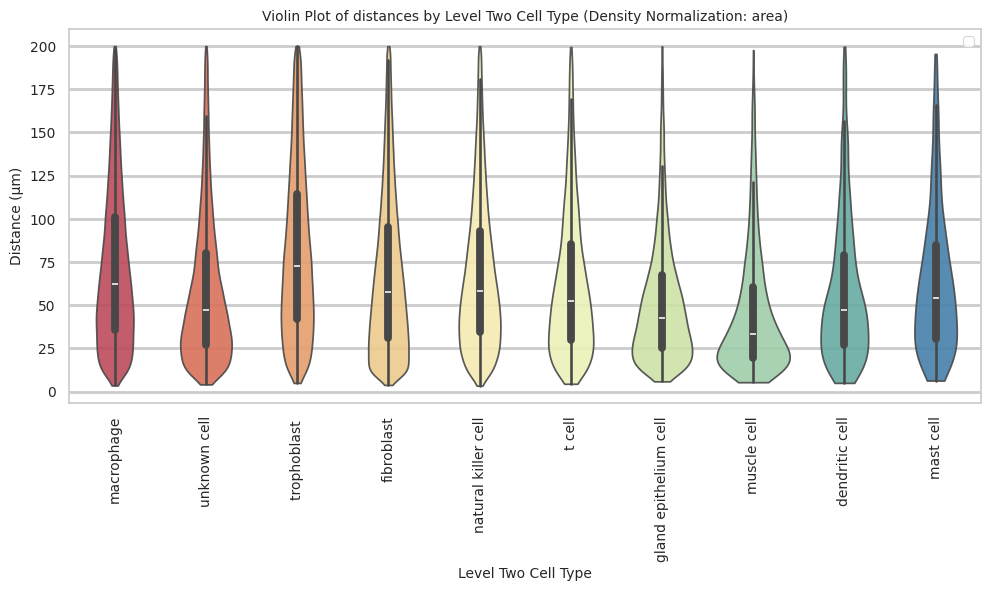
plot_distance_distribution_boxplots_by_region(df_all_edges_with_cell_type_level, cell_type_level, os.path.join(basepath, figures_output_dir))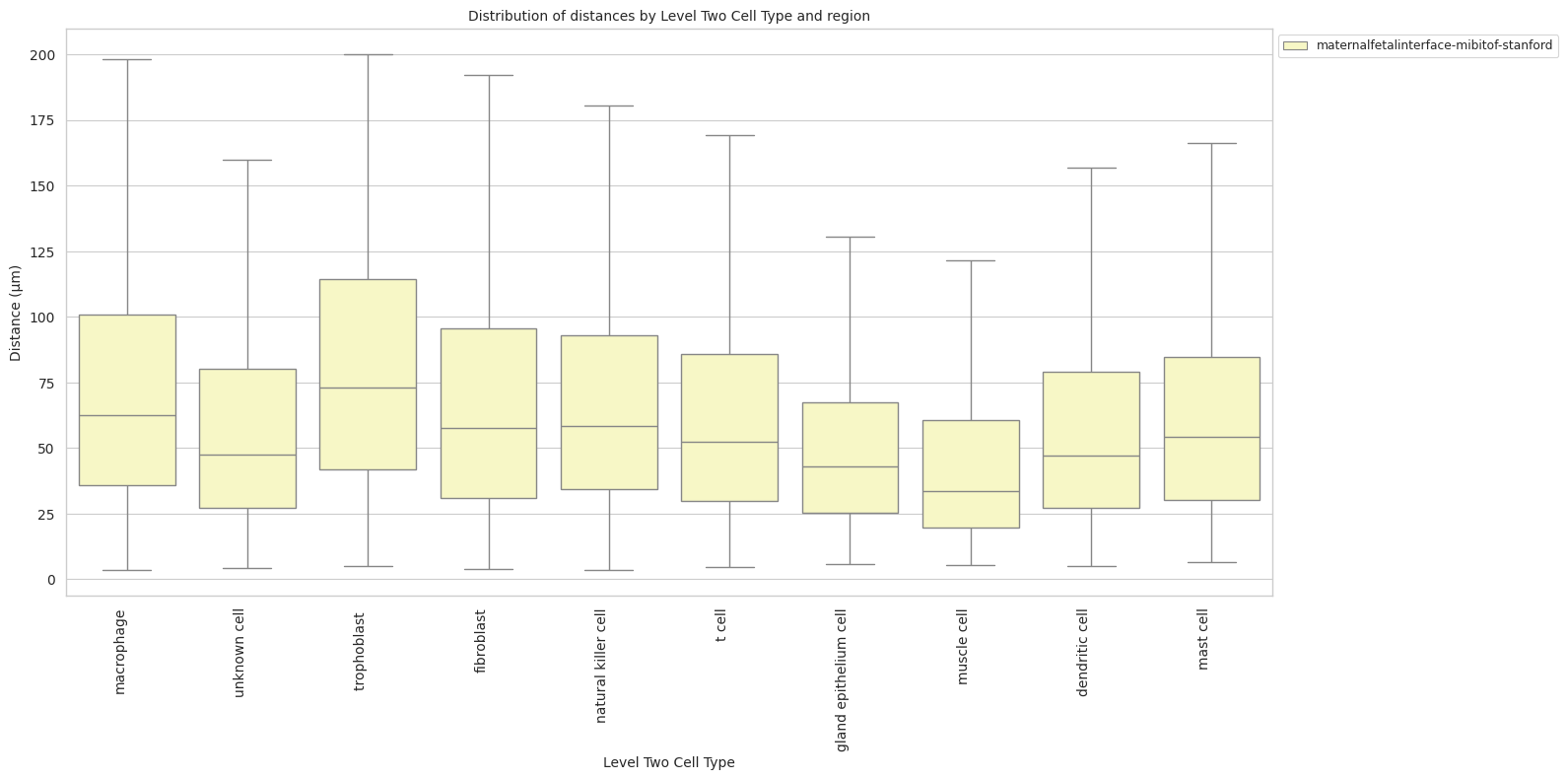
plot_distance_distribution_heatmap(df_all_edges_with_cell_type_level, cell_type_level, os.path.join(basepath, figures_output_dir))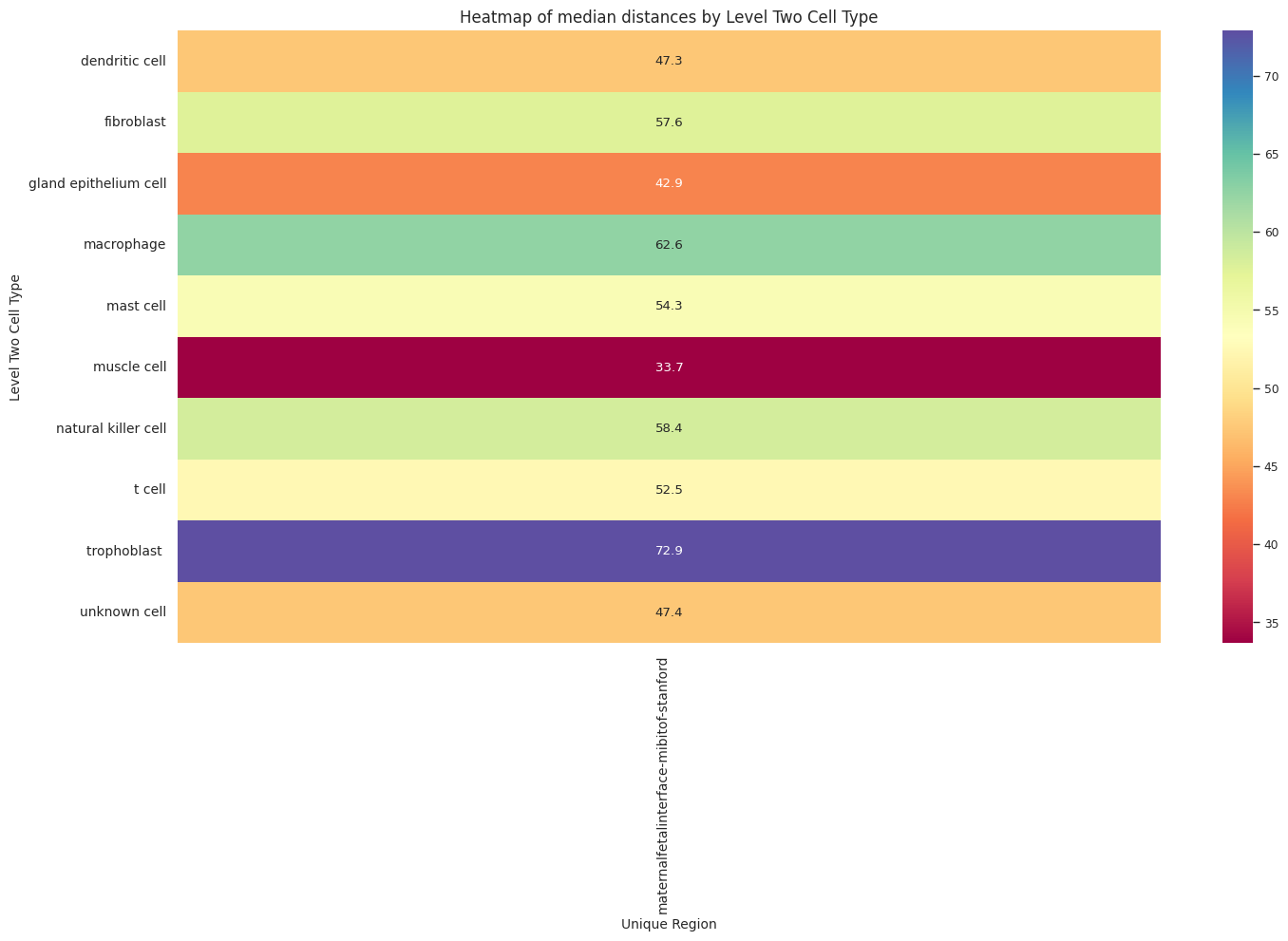
plot_violin_plots_all_regions(df_all_edges_with_cell_type_level, cell_type_level, os.path.join(basepath, figures_output_dir), density_norm="count") # Or, density_norm="count" or "area" based on preference.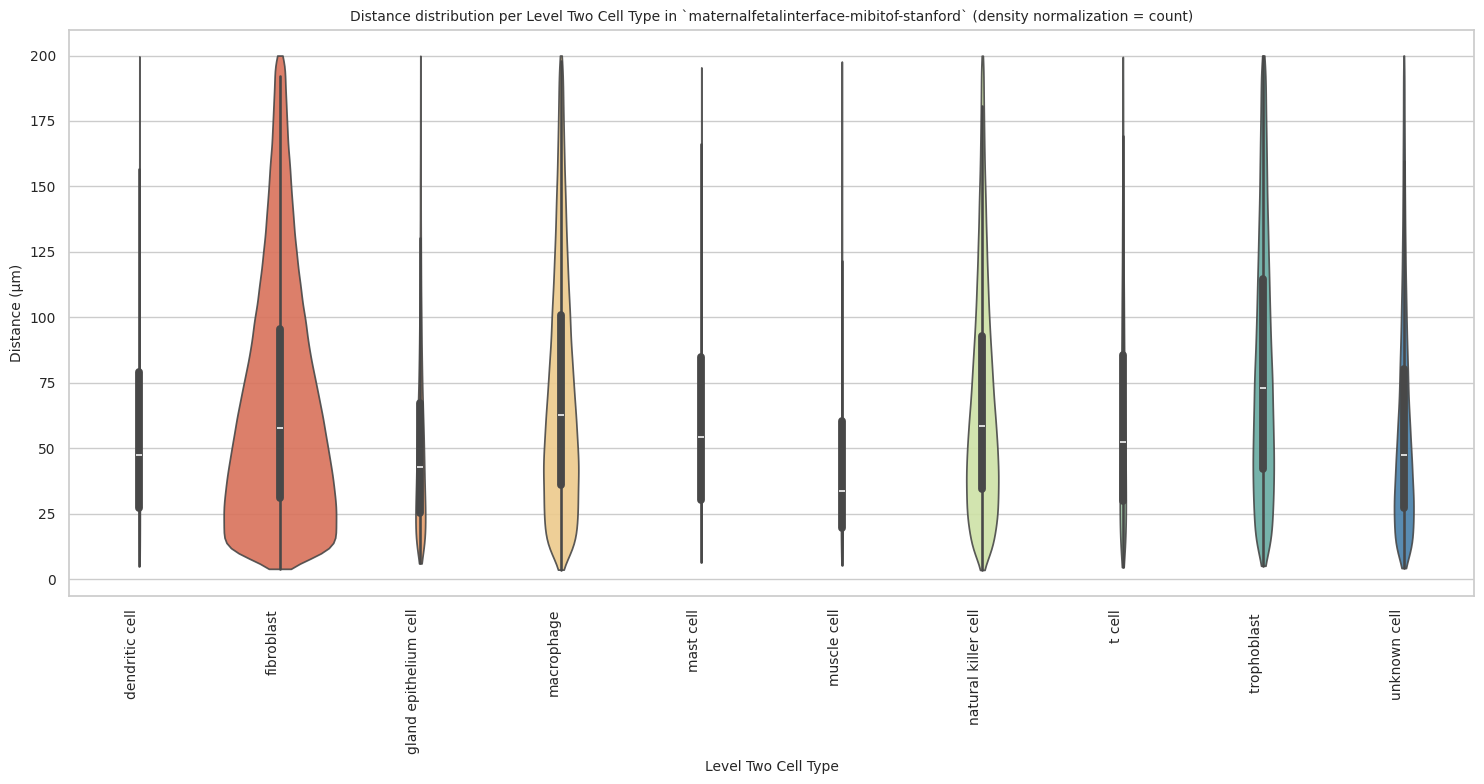
Level Three Cell Type Analysis
# Get mean, median, minimum, maximum distance per cell type in all unique regions.
cell_type_level = 'Level Three Cell Type'
df_all_edges_with_cell_type_level = df_all_edges_with_cell_types[(df_all_edges_with_cell_types['Anchor Cell Type Level'] == cell_type_level) & (df_all_edges_with_cell_types['Anchor Cell Type'] == anchor_cell_type_dict[cell_type_level])]
df_distance_stats_cell_type_level = df_all_edges_with_cell_type_level.groupby([cell_type_level, 'Unique Region']).agg(
mean_distance=('Distance', 'mean'),
median_distance=('Distance', 'median'),
min_distance=('Distance', 'min'),
max_distance=('Distance', 'max')
).reset_index()
df_distance_stats_cell_type_level| Level Three Cell Type | Unique Region | mean_distance | median_distance | min_distance | max_distance | |
|---|---|---|---|---|---|---|
| 0 | dendritic cell | maternalfetalinterface-mibitof-stanford | 58.324142 | 47.317462 | 5.098016 | 199.666668 |
| 1 | fibroblast | maternalfetalinterface-mibitof-stanford | 77.889958 | 69.612277 | 3.910000 | 199.987996 |
| 2 | glandular cell of placenta | maternalfetalinterface-mibitof-stanford | 51.287235 | 42.921044 | 5.981150 | 199.885151 |
| 3 | hofbauer cell | maternalfetalinterface-mibitof-stanford | 51.969181 | 51.969181 | 51.969181 | 51.969181 |
| 4 | macrophage:1a | maternalfetalinterface-mibitof-stanford | 75.795827 | 68.247143 | 4.724471 | 199.456378 |
| 5 | macrophage:1b | maternalfetalinterface-mibitof-stanford | 69.105499 | 58.802292 | 5.431946 | 199.992200 |
| 6 | macrophage:2a | maternalfetalinterface-mibitof-stanford | 71.011379 | 61.357107 | 3.604842 | 199.978822 |
| 7 | macrophage:2b | maternalfetalinterface-mibitof-stanford | 76.811644 | 67.782982 | 6.839707 | 199.575914 |
| 8 | macrophage:2c | maternalfetalinterface-mibitof-stanford | 79.310856 | 70.081228 | 5.098016 | 199.924919 |
| 9 | mast cell | maternalfetalinterface-mibitof-stanford | 63.148860 | 54.321564 | 6.448537 | 195.472628 |
| 10 | muscle cell | maternalfetalinterface-mibitof-stanford | 45.641366 | 33.661210 | 5.487947 | 197.687141 |
| 11 | myofibroblast | maternalfetalinterface-mibitof-stanford | 44.639942 | 33.840141 | 4.423660 | 199.978440 |
| 12 | natural killer cell | maternalfetalinterface-mibitof-stanford | 67.902679 | 58.362562 | 3.497210 | 199.930654 |
| 13 | t cell:cd4+ alpha-beta | maternalfetalinterface-mibitof-stanford | 57.463278 | 47.325539 | 4.976618 | 198.665326 |
| 14 | t cell:cd8+ alpha-beta | maternalfetalinterface-mibitof-stanford | 61.399550 | 51.377460 | 4.576538 | 198.576424 |
| 15 | t cell:mature natural killer | maternalfetalinterface-mibitof-stanford | 67.510450 | 58.018392 | 5.878019 | 199.463659 |
| 16 | t cell:regulatory | maternalfetalinterface-mibitof-stanford | 67.053392 | 56.678818 | 8.924741 | 179.373567 |
| 17 | trophoblast:hla-g minus, cd57- ck7 low extravi... | maternalfetalinterface-mibitof-stanford | 72.329049 | 59.481490 | 5.968356 | 198.836091 |
| 18 | trophoblast:hla-g+ cd56+ extravillous | maternalfetalinterface-mibitof-stanford | 62.454379 | 51.417615 | 5.083000 | 199.396583 |
| 19 | trophoblast:hla-g+ ck7+ extravillous | maternalfetalinterface-mibitof-stanford | 83.334643 | 75.236264 | 5.981150 | 199.994111 |
| 20 | trophoblast:hla-g+ ck7- extravillous | maternalfetalinterface-mibitof-stanford | 83.224385 | 75.506038 | 5.529575 | 199.973471 |
| 21 | unknown cell | maternalfetalinterface-mibitof-stanford | 58.887208 | 47.444914 | 4.211199 | 199.992200 |
# Get top and bottom cell types for each unique region in the dataset.
unique_regions = df_all_edges_with_cell_type_level['Unique Region'].unique()
for region in unique_regions:
top_bottom = get_top_bottom_cell_types_by_mean(df_all_edges_with_cell_type_level, cell_type_level, region)
print(f"\nTop 5 cell types in {region}:")
print(top_bottom[0])
print(f"\nBottom 5 cell types in {region}:")
print(top_bottom[1])
Top 5 cell types in maternalfetalinterface-mibitof-stanford:
Level Three Cell Type mean_distance
19 trophoblast:hla-g+ ck7+ extravillous 83.334643
20 trophoblast:hla-g+ ck7- extravillous 83.224385
8 macrophage:2c 79.310856
1 fibroblast 77.889958
7 macrophage:2b 76.811644
Bottom 5 cell types in maternalfetalinterface-mibitof-stanford:
Level Three Cell Type mean_distance
13 t cell:cd4+ alpha-beta 57.463278
3 hofbauer cell 51.969181
2 glandular cell of placenta 51.287235
10 muscle cell 45.641366
11 myofibroblast 44.639942# Get top and bottom cell types for each unique region in the dataset.
unique_regions = df_all_edges_with_cell_type_level['Unique Region'].unique()
for region in unique_regions:
top_bottom = get_top_bottom_cell_types_by_median(df_all_edges_with_cell_type_level, cell_type_level, region)
print(f"\nTop 5 cell types in {region}:")
print(top_bottom[0])
print(f"\nBottom 5 cell types in {region}:")
print(top_bottom[1])
Top 5 cell types in maternalfetalinterface-mibitof-stanford:
Level Three Cell Type median_distance
20 trophoblast:hla-g+ ck7- extravillous 75.506038
19 trophoblast:hla-g+ ck7+ extravillous 75.236264
8 macrophage:2c 70.081228
1 fibroblast 69.612277
4 macrophage:1a 68.247143
Bottom 5 cell types in maternalfetalinterface-mibitof-stanford:
Level Three Cell Type median_distance
13 t cell:cd4+ alpha-beta 47.325539
0 dendritic cell 47.317462
2 glandular cell of placenta 42.921044
11 myofibroblast 33.840141
10 muscle cell 33.661210calculate_regional_variability(df_all_edges_with_cell_type_level, cell_type_level)
Regional Variability Analysis:
Mean: Average distance in each region
Std: Standard deviation of distances
CV: Coefficient of Variation (std/mean * 100%)
mean std CV (%)
Unique Region
maternalfetalinterface-mibitof-stanford 67.89 44.96 66.2
Cell Type Variability Analysis (sorted by CV):
mean std CV (%)
Level Three Cell Type
myofibroblast 44.64 35.31 79.1
muscle cell 45.64 35.99 78.9
dendritic cell 58.32 41.41 71.0
unknown cell 58.89 41.57 70.6
t cell:cd4+ alpha-beta 57.46 40.41 70.3
trophoblast:hla-g+ cd56+ extravillous 62.45 42.43 67.9
glandular cell of placenta 51.29 34.72 67.7
t cell:regulatory 67.05 45.09 67.2
trophoblast:hla-g minus, cd57- ck7 low extravil... 72.33 48.30 66.8
t cell:cd8+ alpha-beta 61.40 40.96 66.7
mast cell 63.15 41.34 65.5
t cell:mature natural killer 67.51 43.43 64.3
macrophage:1b 69.11 44.25 64.0
macrophage:2a 71.01 45.29 63.8
natural killer cell 67.90 42.91 63.2
macrophage:2b 76.81 46.70 60.8
macrophage:2c 79.31 47.08 59.4
macrophage:1a 75.80 44.50 58.7
fibroblast 77.89 45.73 58.7
trophoblast:hla-g+ ck7- extravillous 83.22 48.60 58.4
trophoblast:hla-g+ ck7+ extravillous 83.33 48.07 57.7
hofbauer cell 51.97 NaN NaNplot_violin_cells_per_celltype(df_all_edges_with_cell_type_level, cell_type_level, os.path.join(basepath, figures_output_dir), density_norm='area')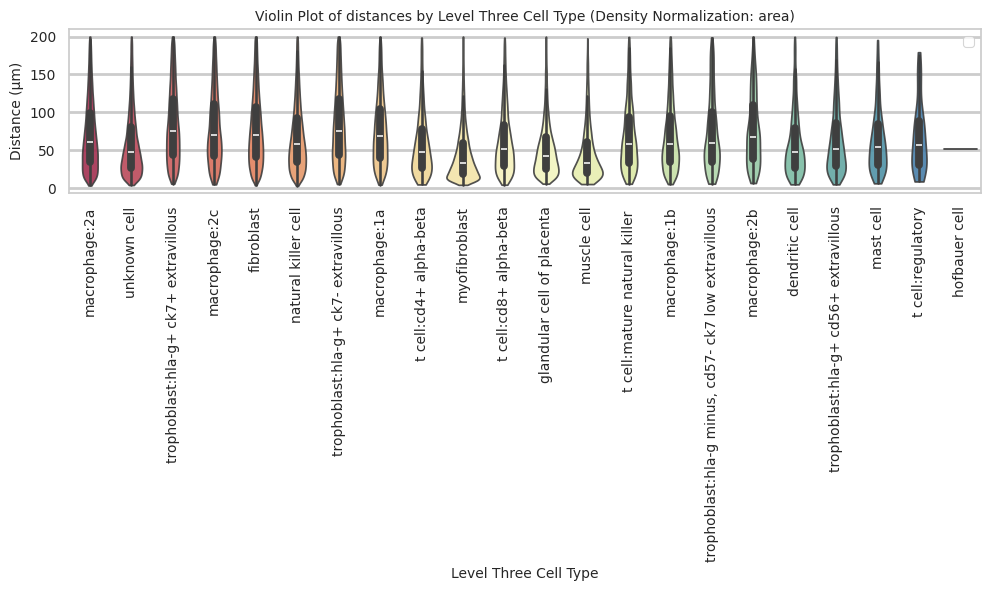
plot_distance_distribution_boxplots_by_region(df_all_edges_with_cell_type_level, cell_type_level, os.path.join(basepath, figures_output_dir))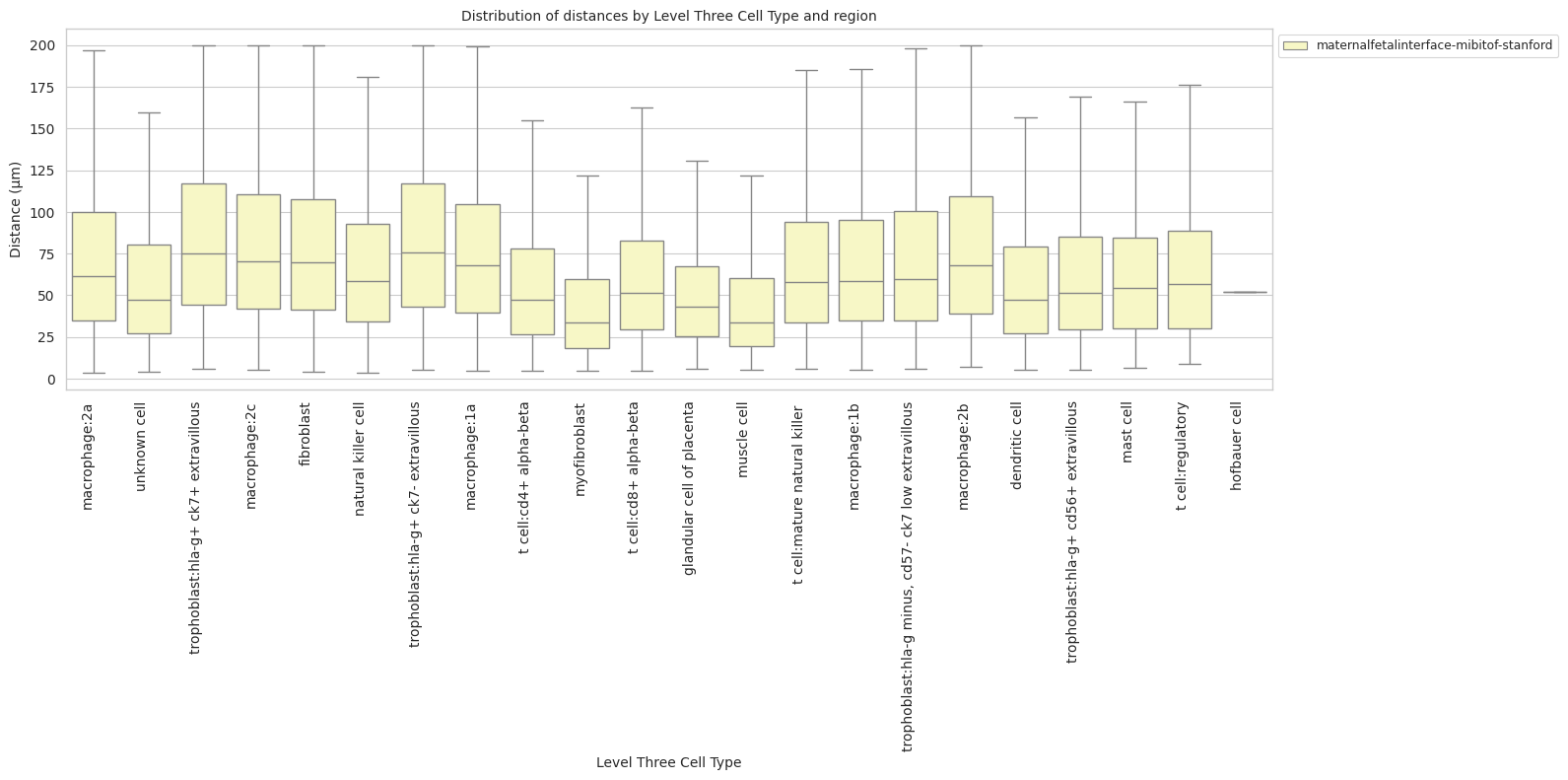
plot_distance_distribution_heatmap(df_all_edges_with_cell_type_level, cell_type_level, os.path.join(basepath, figures_output_dir))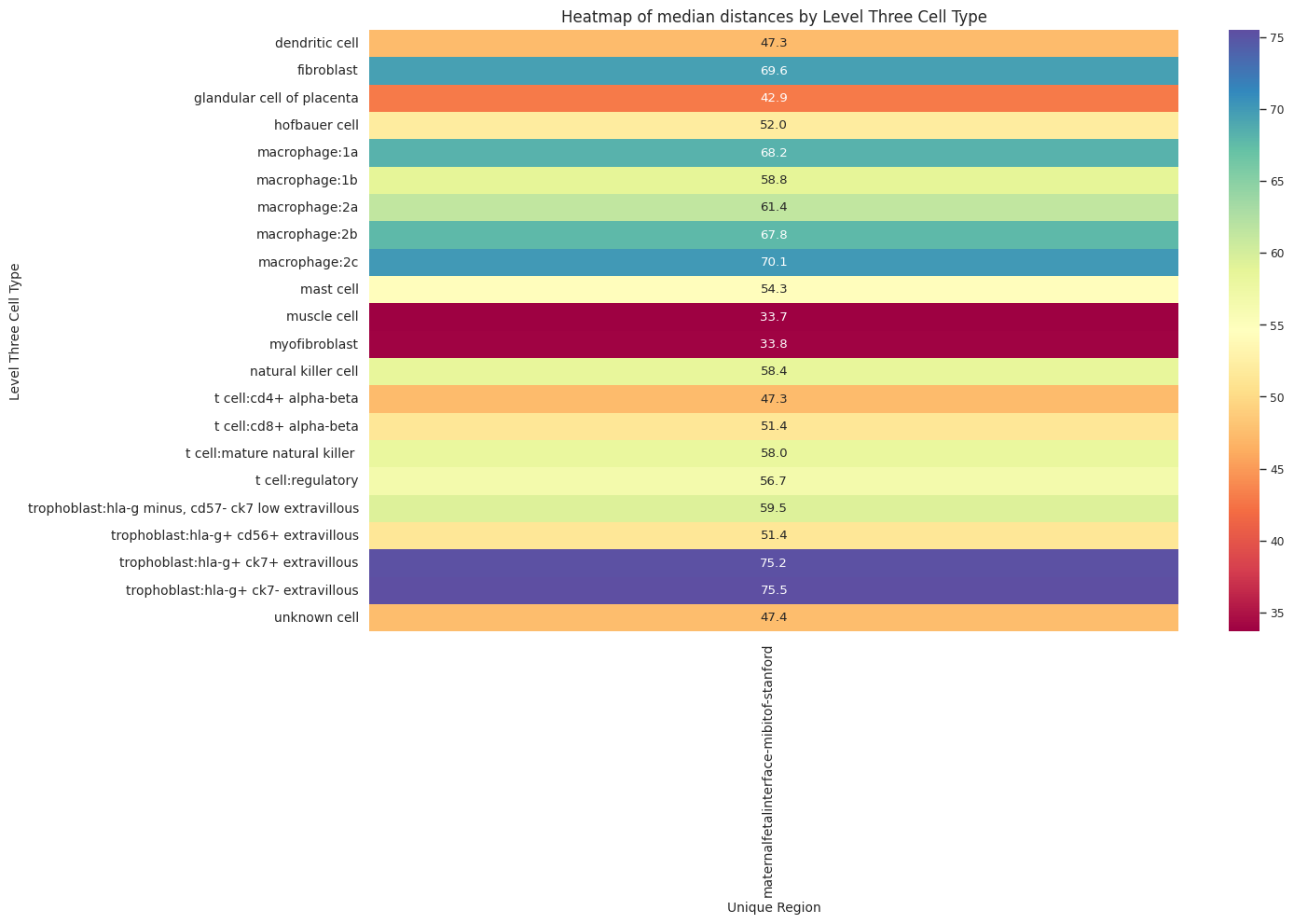
plot_violin_plots_all_regions(df_all_edges_with_cell_type_level, cell_type_level, os.path.join(basepath, figures_output_dir), density_norm="count") # Or, density_norm="count" or "area" based on preference.